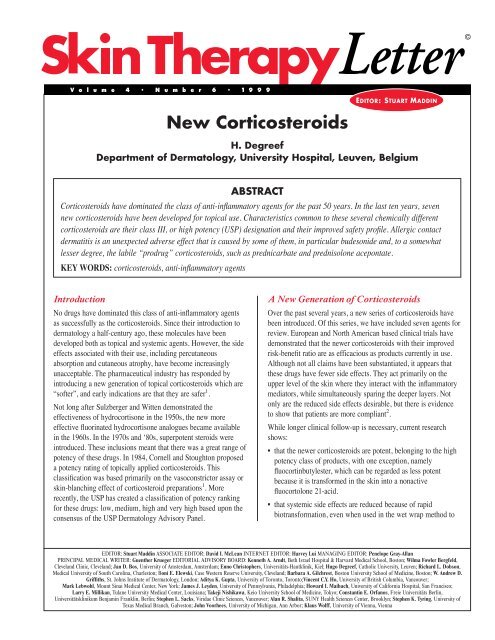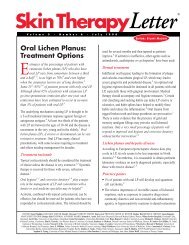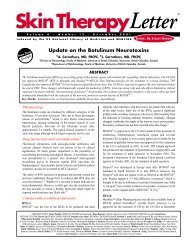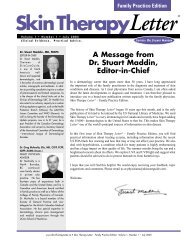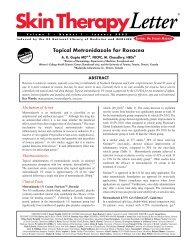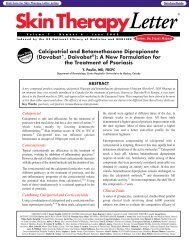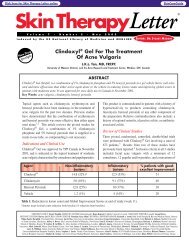Download PDF - Skin Therapy Letter
Download PDF - Skin Therapy Letter
Download PDF - Skin Therapy Letter
You also want an ePaper? Increase the reach of your titles
YUMPU automatically turns print PDFs into web optimized ePapers that Google loves.
V o l u m e 4 • N u m b e r 6 • 1 9 9 9<br />
New Corticosteroids<br />
H. Degreef<br />
Department of Dermatology, University Hospital, Leuven, Belgium<br />
ABSTRACT<br />
Corticosteroids have dominated the class of anti-inflammatory agents for the past 50 years. In the last ten years, seven<br />
new corticosteroids have been developed for topical use. Characteristics common to these several chemically different<br />
corticosteroids are their class III, or high potency (USP) designation and their improved safety profile. Allergic contact<br />
dermatitis is an unexpected adverse effect that is caused by some of them, in particular budesonide and, to a somewhat<br />
lesser degree, the labile “prodrug” corticosteroids, such as prednicarbate and prednisolone acepontate.<br />
KEY WORDS: corticosteroids, anti-inflammatory agents<br />
Introduction<br />
No drugs have dominated this class of anti-inflammatory agents<br />
as successfully as the corticosteroids. Since their introduction to<br />
dermatology a half-century ago, these molecules have been<br />
developed both as topical and systemic agents. However, the side<br />
effects associated with their use, including percutaneous<br />
absorption and cutaneous atrophy, have become increasingly<br />
unacceptable. The pharmaceutical industry has responded by<br />
introducing a new generation of topical corticosteroids which are<br />
“softer”, and early indications are that they are safer 1 .<br />
Not long after Sulzberger and Witten demonstrated the<br />
effectiveness of hydrocortisone in the 1950s, the new more<br />
effective fluorinated hydrocortisone analogues became available<br />
in the 1960s. In the 1970s and ‘80s, superpotent steroids were<br />
introduced. These inclusions meant that there was a great range of<br />
potency of these drugs. In 1984, Cornell and Stoughton proposed<br />
a potency rating of topically applied corticosteroids. This<br />
classification was based primarily on the vasoconstrictor assay or<br />
skin-blanching effect of corticosteroid preparations 1 . More<br />
recently, the USP has created a classification of potency ranking<br />
for these drugs: low, medium, high and very high based upon the<br />
consensus of the USP Dermatology Advisory Panel.<br />
A New Generation of Corticosteroids<br />
Over the past several years, a new series of corticosteroids have<br />
been introduced. Of this series, we have included seven agents for<br />
review. European and North American based clinical trials have<br />
demonstrated that the newer corticosteroids with their improved<br />
risk-benefit ratio are as efficacious as products currently in use.<br />
Although not all claims have been substantiated, it appears that<br />
these drugs have fewer side effects. They act primarily on the<br />
upper level of the skin where they interact with the inflammatory<br />
mediators, while simultaneously sparing the deeper layers. Not<br />
only are the reduced side effects desirable, but there is evidence<br />
to show that patients are more compliant 2 .<br />
While longer clinical follow-up is necessary, current research<br />
shows:<br />
• that the newer corticosteroids are potent, belonging to the high<br />
potency class of products, with one exception, namely<br />
fluocortinbutylester, which can be regarded as less potent<br />
because it is transformed in the skin into a nonactive<br />
fluocortolone 21-acid.<br />
• that systemic side effects are reduced because of rapid<br />
biotransformation, even when used in the wet wrap method to<br />
EDITOR: Stuart Maddin ASSOCIATE EDITOR: David I. McLean INTERNET EDITOR: Harvey Lui MANAGING EDITOR: Penelope Gray-Allan<br />
PRINCIPAL MEDICAL WRITER: Guenther Krueger EDITORIAL ADVISORY BOARD: Kenneth A. Arndt, Beth Israel Hospital & Harvard Medical School, Boston; Wilma Fowler Bergfeld,<br />
Cleveland Clinic, Cleveland; Jan D. Bos, University of Amsterdam, Amsterdam; Enno Christophers, Universitäts-Hautklinik, Kiel; Hugo Degreef, Catholic University, Leuven; Richard L. Dobson,<br />
Medical University of South Carolina, Charleston; Boni E. Elewski, Case Western Reserve University, Cleveland; Barbara A. Gilchrest, Boston University School of Medicine, Boston; W. Andrew D.<br />
Griffiths, St. Johns Institute of Dermatology, London; Aditya K. Gupta, University of Toronto, Toronto;Vincent C.Y. Ho, University of British Columbia, Vancouver;<br />
Mark Lebwohl, Mount Sinai Medical Center, New York; James J. Leyden, University of Pennsylvania, Philadelphia; Howard I. Maibach, University of California Hospital, San Francisco;<br />
Larry E. Millikan, Tulane University Medical Center, Louisiana; Takeji Nishikawa, Keio University School of Medicine, Tokyo; Constantin E. Orfanos, Freie Universitäts Berlin,<br />
Universitätsklinikum Benjamin Franklin, Berlin; Stephen L. Sacks, Viridae Clinic Sciences, Vancouver; Alan R. Shalita, SUNY Health Sciences Center, Brooklyn; Stephen K. Tyring, University of<br />
Texas Medical Branch, Galveston; John Voorhees, University of Michigan, Ann Arbor; Klaus Wolff, University of Vienna, Vienna
treat atopic dermatitis. However, in very young children and in<br />
erythrodermic patients, one should beware of potential<br />
hypothalamus and pituitary axis (HPA) suppression, even with<br />
the new corticosteroids.<br />
• that local safety with short-term use appears satisfactory 1 .<br />
Indeed, the new generation of corticosteroids does not cause as<br />
much cutaneous atrophy or systemic absorption as the older<br />
corticosteroids do. This is because of their molecular<br />
configuration, which displays a rapidly declining concentration<br />
gradient in the skin. They act primarily in the top layers where<br />
the most important mediators of the inflammatory reaction are.<br />
The action in deeper layers is much diminished. With restricted<br />
duration of treatment (up to 6 weeks) clinical safety has been<br />
claimed. However, skin atrophy and some telangiectasia have<br />
been noted.<br />
Classifications<br />
The new corticosteroids can be classified in several ways.<br />
Chemically, they can be divided as follows:<br />
• Asymmetric acetonides: budesonide<br />
• C 21 -carboxylesters: alclometasone, fluocortinbutylester, and<br />
methylprednisolone aceponate.<br />
• C 17 -prednicarbonates: 17-prednicarbate<br />
• Carbothiates: fluticasone propionate<br />
• Mometasone furoate<br />
Another way to classify these drugs is by chemical stability:<br />
• Some of these drugs can be regarded as pro-drugs, that undergo<br />
metabolization and acryl-exchanges, immediately after<br />
application to form the active molecule. They include:<br />
prednicarbate, methylprenisolone aceponate, alclometasone,<br />
and fluocortin butylesters.<br />
The Issue of Side Effects<br />
The object of the changes made in the corticosteroid molecule<br />
between the 1950s and the mid-1980s, was to obtain better skin<br />
penetration, slower enzyme degradation, and greater affinity for<br />
the cytosol receptors 1 . However, the changes that increased<br />
potency, also led to more side effects.<br />
While systemic side effects are of concern, cutaneous side effects<br />
are more common and include problems such as striae formation,<br />
atrophy, purpura, peri-oral dermatitis, steroid rosacea,<br />
hypertrichosis, and steroid acne 1 .<br />
Side effects are generally related to the duration and potency of<br />
the application, the manner of application (i.e., occlusion), the<br />
presence of penetration-enhancing substances, and the state of the<br />
skin barrier. The anatomic site of application and the patient’s age<br />
can also adversely influence the side effect profile 1 .<br />
Application<br />
Several of the new corticosteroids may only need to be applied<br />
once daily, in contrast to the older corticosteroids, for which a<br />
twice-daily application was recommended.<br />
Contact Allergy<br />
The increase in the number of reports of contact allergic<br />
reactions, following the introduction of some of these newer<br />
corticosteroids, was unexpected.<br />
In order to explain the increased allergenicity of the newer<br />
corticosteroids, data from the literature and clinical studies were<br />
reviewed and an attempt was made to define some of the more<br />
important groups of cross-reacting molecules 4 .<br />
Group A – hydrocortisone type: no substitution on the D-ring,<br />
except a short chain ester on C 17 or C 21 or a thioester on C 21 .<br />
Group B – triamcinolone type: C 16 , C 17 -cis-ketal or -diol<br />
structure.<br />
Group C – betamethasone type: C 16 -methylsubstitution, no side<br />
chain on C 17 ; possible side chain on C 21 .<br />
Group D – hydrocortisone-17-butyrate type: long chain ester at<br />
C 17 and/or C 21 with or without C 16 -methylsubstitution.<br />
Tixocortol pivalate (1% petrolatum) was identified as a good<br />
screening agent for Group A. Budesonide (1% ethanol) was found<br />
to be a marker for the Group B, but also for certain esters, such as<br />
hydrocortisone-17-butyrate in Group D. Budesonide is virtually a<br />
1:1 mixture of two diastereomers (R- and S-isomer). The R-<br />
isomer is the marker for the B Group, the S-isomer for the D<br />
Group. There is no marker for the Group C, but it seems that its<br />
members cause almost no contact sensitivity and do not crossreact<br />
with other groups.<br />
In recent studies 5,6 it has been shown that Group D should be<br />
divided into two subgroups. Corticosteroids with a<br />
methylsubstitution on C 16 and halogenation on the B ring can be<br />
classified as Group D 1 . To this group belong not only the older<br />
molecules like betamethasone dipropionate, betamethasone-17-<br />
valerate, and clobetasol propionate, but also the newer stable<br />
corticosteroids: fluticasone propionate and mometasone fuoroate.<br />
They rarely cause positive patch test results, and can safely be<br />
used even in patients who are allergic to other corticosteroids.<br />
The corticosteroids with a long ester on C 17 , possibly a side<br />
chain on C 21 , no methyl substitution on C 16 , and no halogenation<br />
on the B ring can be classified in Group D 2 . To this group<br />
belong hydrocortisone-17-butyrate and hydrocortisone-17-<br />
valerate, as well as the “labile” new corticosteroids like<br />
prednicarbate and methylprednisolone aceponate. They can cause<br />
allergic reactions. Budesonide (S-isomer) is the marker for this<br />
Group D 2 , but they can cross-react with Group A. Fluocortin<br />
butylester belongs to Group C.<br />
2<br />
<strong>Skin</strong> <strong>Therapy</strong> <strong>Letter</strong> • Editor: Dr. Stuart Maddin • Vol. 4 No. 6
Electrolysis For The Treatment Of<br />
Hypertrichosis And Hirsutism<br />
Robert N. Richards M.D.,F.R.C.P.(C)<br />
Department of Medicine (Dermatology), North York General Hospital<br />
University of Toronto, Ontario, Canada<br />
ABSTRACT<br />
There are three electrolysis modalities. In galvanic electrolysis, a direct electric current is passed down a needle inserted<br />
into the hair follicle, destroying the follicle. In thermolysis a high frequency alternating current is passed down the needle<br />
and produces destructive heat. The blend is the third modality which combines galvanic electrolysis and thermolysis.<br />
Electrolysis satisfactorily removes hair from women and men with hypertrichosis, but women with hirsutism require<br />
concomitant hormonal management. Scarring does not occur with properly performed electrolysis.<br />
Shaving one to five days before electrolysis greatly increases efficacy because it ensures that only growing anagen hairs<br />
are epilated. The judicious use of ice packs and the recent availability of EMLA (lidocaine/prilocaine cream) have been<br />
beneficial in reducing the sensations of electrolysis.<br />
KEY WORDS: Galvanic electrolysis, thermolysis, hypertrichosis, hirsutism<br />
Introduction<br />
Electrolysis has been used to produce permanent hair loss since<br />
1875, when Dr. Charles Michel first used it in St. Louis, Missouri<br />
to remove the ingrown hairs of trichiasis 1 . The term electrolysis is<br />
a generic term referring to the permanent removal of hair by the<br />
insertion of a needle into the hair follicle. The needle acts as a<br />
conductor to carry the appropriate current to the base of the hair<br />
follicle, and particularly to the dermal papilla.<br />
In galvanic electrolysis a direct electric (galvanic) current is<br />
passed down the needle into the hair follicle. The current acts on<br />
tissue saline to produce sodium hydroxide, which destroys the<br />
lower hair follicle and dermal papilla. Galvanic electrolysis is the<br />
most certain method of permanent hair removal, but is slow and<br />
can require a minute or more for each hair.<br />
In thermolysis (also called short-wave, diathermy, high radio<br />
frequency) the high frequency current passed down the needle<br />
produces heat, which destroys the base of the follicle.<br />
Thermolysis is much faster than galvanic electrolysis and requires<br />
only a few seconds. This procedure involves the generation of<br />
much higher energy for only a fraction of a second. The flash<br />
method is best used with insulated needles, which protect the<br />
upper hair follicle and restricts high energy delivery to the lower<br />
end of the follicle. The widely referenced method employed by<br />
Kligman and Peters should be referred to 2 .<br />
The blend method shortens treatment time. It combines galvanic<br />
electrolysis, for the localized destruction of the hair papilla, and<br />
high frequency thermolysis to shorten treatment time. In this<br />
combination, the heat produced from thermolysis increases the<br />
temperature of the sodium hydroxide produced by galvanic<br />
electrolysis. This, in turn, increases efficiency in destroying the<br />
hair follicle. The several electrolysis options outlined result in<br />
permanent hair removal, but the choice of modality depends upon<br />
the experience and preference of the operator.<br />
Electrolysis procedures and equipment are standardized and in<br />
most jurisdictions monitored by regulators. Electrolysis is safe<br />
and scarring does not occur when properly performed by trained<br />
electrologists. Much of the scarring previously attributed to<br />
electrolysis actually resulted from inappropriate plucking and/or<br />
picking. However, if the electrolysis operator is unskilled or if the<br />
current used is too high, scarring may occur.<br />
Hyperpigmentation may occur, especially so in patients with <strong>Skin</strong><br />
Types III and IV, but is usually of a transient nature. Disease<br />
transmission may be of concern, but with proper regulatory<br />
standards in place, such an occurrence is minimized 2,3,4,5,6 .<br />
When to Use Electrolysis<br />
Electrolysis can be most advantageously employed for localized<br />
areas of hair removal. The regions that are most frequently of<br />
cosmetic concern for women are the face, eyebrows, breasts,<br />
WE’RE ON THE NET!<br />
http://www.derm.ubc.ca<br />
<strong>Skin</strong> <strong>Therapy</strong> <strong>Letter</strong> • Editor: Dr. Stuart Maddin • Vol. 4 No. 6 3
lower abdomen and inner thighs (bikini area), and the axillae.<br />
Men sometimes wish to have hair removed from between the<br />
eyebrows, around the ears, as well as in areas where ingrown<br />
hairs are a problem (the beard area) and on the upper back and<br />
shoulders.<br />
Electrolysis is effective but often impractical for large hirsute<br />
areas such as the trunk or limbs. Hair removal in such cases can<br />
be achieved, but frequent visits are required for up to three hours<br />
a week for one or two years and few can afford the time or<br />
expense.<br />
A woman undergoing menopausal changes may develop hairs on<br />
the chin. In most instances this may require three to six visits,<br />
lasting 15 to 30 minutes each. Further followup visits would be<br />
required over a period of months to deal with hair regrowth. One<br />
or two visits per year afterwards may be required. An individual<br />
with dense moustache hair would require more sessions over 12-<br />
24 months. Permanent hair removal of a few unwanted hairs<br />
around the nipples would require 1 to 5 hours of electrolysis at<br />
appropriate intervals.<br />
Rates for electrolysis vary considerably, but typical studio rates<br />
are $40.00 to $60.00 per hour.<br />
treated. This is important because in some body areas more than<br />
70% of the hairs may be in telogen phase, and telogen hairs do<br />
not respond satisfactorily to electrolysis 4,6 .<br />
Minimal postinflammatory erythema and occasional whealing are<br />
normal after electrolysis, but these disappear within an hour in<br />
most people. Discomfort is usually minimal and EMLA<br />
(lidocaine/prilocaine cream) and ice packs may be used 7 .<br />
The use of electronic tweezers is not a valid option. This<br />
procedure does not produce permanent hair removal because hair<br />
is not an electric conductor.<br />
Conclusion<br />
Of the three modalities, galvanic electrolysis is slow and used the<br />
least. Thermolysis and the blend are probably used equally as<br />
often. Both are effective and the choice depends on operator<br />
preference and experience. There is not clear, documented<br />
difference.<br />
The effectiveness of electrolysis is well documented 4,6 , and it is<br />
most effective in dealing with hair removal from localized areas.<br />
Electrolysis is not as effective in hair removal from large hirsute<br />
areas.<br />
HAIR TYPE VISITS COST (Estimated)<br />
Chin hairs—few<br />
3 – 6 visits<br />
15 – 30 minutes/visit<br />
$40 – 60/hour CDN<br />
Moustache hair—dense<br />
Weekly sessions for 6 months, then every<br />
second week for 6 months, then once or<br />
twice/month for one year<br />
$40 – 60/hour CDN<br />
Nipple hairs 1 – 5 hours at appropriate intervals $40 – 60/hour CDN<br />
Hypertrichosis and Hirsutism<br />
In hypertrichosis there is little or no new hair growth and the<br />
results of electrolysis are rapidly evident. However, in dealing<br />
with hirsutism, new hair growth is continually occurring. For best<br />
results a team approach might be considered. Electrolysis could<br />
be combined with hormonal administration under the direction of<br />
an endocrinologist.<br />
Instructing patients about good grooming and stressing that<br />
shaving is not harmful will help to maximize improvement and<br />
appearance 5,8 .<br />
Electrolysis Results<br />
The results of electrolysis are well documented. As well, posttreatment<br />
biopsy and histopathology studies have shown its<br />
effectiveness 4,6 . Electrolysis may be performed on patients with<br />
varying skin types, all hair types and colours, or on most<br />
anatomic sites on the body. It does not adversely effect nevi or<br />
tattoos. Hair removal can also be carried out in the periorbital area.<br />
Shaving one to five days prior to electrolysis greatly increases its<br />
efficacy because it ensures that only growing anagen hairs are<br />
References<br />
1 Michel CE. Trichiasis and districhiasis with an improved method for their radical<br />
treatment. St. Louis Clinical Record 2:145-8 (1875).<br />
2 Kligman AM, Peters L. Histologic changes of human hair follicles after<br />
electrolysis: a comparison of two methods. Cutis 34(2):169-76 (1984 Aug).<br />
3 Wagner RF Jr, Tomich JM, Grande DJ. Electrolysis and thermolysis for permanent<br />
hair removal. J Am Acad Dermatol 12(3):441-9 (1985 Mar).<br />
4 Hobbs ER, Ratz JL, James B. Electrosurgical epilation. Dermatol Clin 5(2):437-44<br />
(1987 Apr).<br />
5 Richards RN, Meharg GE. Electrolysis: Observations from 13 years and 140,000<br />
hours of experience. J Am Acad Dermatol 33(4):662-6 (1995 Oct).<br />
6 Richards RN, Meharg GE. Cosmetic And Medical Electrolysis And Temporary<br />
Hair Removal. 2nd Edition. Toronto: Medric Ltd (1997).<br />
7 Wagner RF, Flores CA, Argo LF. A double blind placebo controlled study of a 5%<br />
lidocaine/prilocaine cream (EMLA) for topical anesthesia during thermolysis. J<br />
Dermatol Surg Oncol 20(2):148-50 (1994 Feb).<br />
8 Richards RN, McKenzie MA, Meharg GE. Electroepilation (electrolysis) in<br />
hirsutism. 35,000 hours’ experience on the face and neck. J Am Acad Dermatol<br />
15(4 Pt. 1): 693-7 (1986 Oct).<br />
9 Richards RN, Uy M, Meharg GE. Temporary hair removal in patients with<br />
hirsutism: a clinical study. Cutis 45(3):199-202 (1990 Mar).<br />
4<br />
<strong>Skin</strong> <strong>Therapy</strong> <strong>Letter</strong> • Editor: Dr. Stuart Maddin • Vol. 4 No. 6
The following chart lists a number of these new generation steroids.<br />
Budesonide<br />
Entocort<br />
Astra<br />
Mometasone Furoate<br />
Elocom<br />
Schering-Plough<br />
Carbothioates:<br />
Fluticasone propionate<br />
Cutivate<br />
Glaxo Wellcome<br />
Product Safety Class Side Effects Allergy group<br />
17-Carbonates:<br />
Prednicarbate<br />
Dermatop Emollient Cream<br />
Hoechst-Roussel<br />
Prednitop<br />
Hoechst<br />
C-21-Carboxylates:<br />
1. Fluocortin butylester<br />
Varlane<br />
Schering Corp.-Essex<br />
2. Alclometasone Dipropionate<br />
Modraderm<br />
Schering-Plough<br />
Aclovate<br />
Glaxo Wellcome<br />
3. Methylprednisolone aceponate<br />
Advantan<br />
Schering Corp.-Essex<br />
Stable, asymmetric acetonide. Undergoes<br />
rapid biotransformation in the liver with<br />
fewer systemic effects.<br />
This stable drug is a chlorinated topical<br />
steroid. It has low penetration with high<br />
biliary excretion, and low resorption in the<br />
circulation with rapid biotransformation in<br />
the liver. Consequently, there is minimal<br />
systemic activity. The result: local side<br />
effects are rare.<br />
Labile pro-drug, transformed in the skin<br />
into prednisolone.<br />
In the skin, biotransformed into the<br />
nonactive fluocortolone-21-acid.<br />
No longer available in Europe<br />
Labile pro-drug. Transformed in the skin<br />
into methylprednisolone, in the liver into<br />
nonactive derivatives.<br />
Fluticasone is a fluorinated topical<br />
corticosteroid, which is rapidly<br />
metabolized in the liver. This results in a<br />
locally potent steroid with a low HPA<br />
inhibitory potency.<br />
III (high)<br />
III (high)<br />
III (high)<br />
II (medium)<br />
III (high)<br />
III (high)<br />
III (high)<br />
There may be a<br />
problem with<br />
contact<br />
sensitivity.<br />
Contact<br />
hypersensitivity<br />
is very rare.<br />
Contact<br />
hypersensitivity<br />
is not rare. Can<br />
cross-react with<br />
group A.<br />
Contact<br />
hypersensitivity<br />
is probably rare.<br />
Contact<br />
hypersensitivity<br />
is not rare.<br />
Contact<br />
hypersensitivity<br />
is not rare.<br />
Contact<br />
hypersensitivity<br />
is very rare.<br />
Group B<br />
Group D 1<br />
Group D 2<br />
Group C<br />
Group D 2<br />
Group D 2<br />
Group D 1<br />
Because these agents act via hepatic and extra hepatic<br />
biotransformation, they offer a greater systemic safety. However,<br />
in very young children, and in erythrodermic patients, one should<br />
consider HPA suppression, even with the new corticosteroids.<br />
With restricted duration of treatment (up to 6 weeks), clinical<br />
safety has been claimed.<br />
Some of the newer corticosteroids, particularly budesonide and, to<br />
a lesser extent, prednicarbate and alclometasone dipropionate, are<br />
more prone to cause contact allergic reactions.<br />
Conclusion<br />
Over the past several years, a new series of corticosteroids have<br />
been introduced. They act primarily on the upper level of the skin<br />
where they interact with the most important inflammatory<br />
mediators, while simultaneously sparing the deeper layers. Trials<br />
currently underway worldwide are demonstrating that the newer<br />
corticosteroids with their improved risk-benefit ratio are as<br />
efficacious as products currently in use with better safety. There<br />
are also unsubstantiated claims that these drugs have fewer side<br />
effects. Fewer side effects are not only desirable from a clinical<br />
point of view, but have also been shown to increase patient<br />
compliance with therapy 2 .<br />
References<br />
1. Degreef H, Dooms-Goossens A. The new corticosteroids: are they effective and<br />
safe Dermatol Clin, 11(1):155-60 (1993 Jan).<br />
2. Hadzija BW, Ambrose WW. Comparison of cosmetic and physicochemical<br />
properties of six topical corticosteroid creams. Cutis, 57(2 Suppl):13-8 (1996 Feb).<br />
3. Oranje AP. American Academy of Dermatology, New Orleans (1999 Mar).<br />
4. Coopman S, Degreef H, Dooms-Goossens A. Identifications of cross reaction<br />
patterns in allergic contact dermatitis from topical corticosteroids. Br J Dermatol<br />
121(1):27-34 (1989).<br />
5. Matura M. Contact Allergy to Locally Applied Corticosteroids [dissertation]. KU<br />
Leuven, Belgium (1998 Sep).<br />
6. Goossens A, Matura M. Corticosteroids in Occupational <strong>Skin</strong> Diseases, 3rd<br />
edition by Adams R. WB Saunders Company, Philadelphia, USA (1999).<br />
<strong>Skin</strong> <strong>Therapy</strong> <strong>Letter</strong> • Editor: Dr. Stuart Maddin • Vol. 4 No. 6 5
Update on Drugs<br />
Class Name/Company Approval Dates and Comments<br />
Corticosteroids<br />
Anticancer<br />
Agents<br />
Antihelminthic<br />
Agents<br />
HIV and AIDS<br />
Anticancer<br />
Agents<br />
Topical<br />
Anesthetics<br />
Antidiabetic<br />
Agents<br />
Alendronate<br />
Fosamax<br />
Merck<br />
Alitretinoin<br />
Panretin Gel 0.1%<br />
Ligand Pharmaceutical<br />
Malathion<br />
Ovide 0.5% Lotion<br />
Medicis Pharmaceutical<br />
Abacavir Sulfate<br />
Ziagen<br />
Glaxo Wellcome Inc<br />
Interferon alpha-2a<br />
Roferon-A<br />
Hoffmann-La Roche<br />
Lidocaine Patch 5%<br />
Lidoderm<br />
Endo Pharmaceuticals<br />
Pexiganan acetate<br />
Locilex cream 1%<br />
Magainin Pharmaceuticals<br />
The US FDA approved this drug in June, 1999, for treatment of<br />
glucocorticoid-induced osteoporosis in patients receiving<br />
glucocorticoids in a daily dosage equivalent to > 7.5 mg prednisone<br />
and who have low bone mineral density.<br />
The US FDA approved this small molecule, nonpeptide hormone in<br />
January, 1999, for topical therapy for cutaneous lesions in patients<br />
with AIDS-related Kaposi’s Sarcoma. In June, 1999, HPB Ottawa<br />
issued a Notice of Compliance for this gel for the same indications.<br />
The US FDA approved this lotion in May, 1999, for treatment of<br />
head lice and their ova.<br />
HPB Ottawa approved this nucleoside analogue reverse transcriptase<br />
inhibitor in June, 1999, for the treatment of HIV and AIDS.<br />
The European Commission (CPMP) approved this drug in June,<br />
1999, for the adjuvant treatment of malignant melanoma patients at<br />
risk of relapse following resection.<br />
The US FDA approved this topical anesthetic in May, 1999, for<br />
treatment of pain associated with postherpetic neuralgia. The patch<br />
is an adhesive material with 5% lidocaine applied to a nonwoven<br />
polyester felt backing. The lidocaine is released into the epidermal<br />
and dermal layers of the skin.<br />
The US FDA has deemed this new drug as NOT approvable in July,<br />
1999. It was intended to treat diabetic foot ulcers.<br />
Photodynamic<br />
<strong>Therapy</strong><br />
Antifungal Agents<br />
Antiviral Agents<br />
Antirejection<br />
<strong>Therapy</strong><br />
Aminolevulinic acid<br />
Levulan Photodynamic <strong>Therapy</strong><br />
DUSA Pharmaceuticals<br />
Ketoconazole<br />
Teva<br />
The US FDA issued an approvable letter in June, 1999, for the<br />
treatment of multiple actinic keratoses of the face and scalp.<br />
Drug News<br />
The US FDA approved this generic version of 200 mg ketoconazole<br />
tablets in June, 1999. They are AB rated and bioequivalent to<br />
Janssen’s Nizoral ® tablets.<br />
In May, 1999, The Canadian Dermatology Committee (CDC) recommended that all children entering<br />
preschool or elementary school should be immunized against chicken pox. Previously, the CDC and the<br />
American Academy of Pediatrics advocated that this immunization should take place between the ages of<br />
12-18 months.<br />
The US FDA approved a generic formulation of cyclosporine (SangCya—Sangstat) in May, 1999. The<br />
generic formulation appears to be bioequivalent and therapeutically equivalent to Neoral, and both have<br />
been more consistent in bioavailability than Sandimmune.<br />
<strong>Skin</strong> <strong>Therapy</strong> <strong>Letter</strong>. (ISSN 1201–5989) Copyright 1999 by International <strong>Skin</strong> <strong>Therapy</strong> Newsletter Inc. All rights reserved. Reproduction in whole or in part by any process in whole or in part is<br />
strictly forbidden without prior consent of the publisher in writing.<br />
Published six times yearly by International <strong>Skin</strong> <strong>Therapy</strong> Newsletter Inc., 835 West Tenth Avenue, Vancouver, British Columbia, Canada V5Z 4E8. Tel: (604) 874-6112. Fax: (604) 873-9919.<br />
Annual subscription: Canadian $85 individual; $155 institutional (GST included). US $60 individual; $110 institutional. Outside North America: US$80 individual; $130 institutional. Quotes on<br />
multiple subscriptions and student rates supplied upon request.<br />
Printed in Canada<br />
6<br />
<strong>Skin</strong> <strong>Therapy</strong> <strong>Letter</strong> • Editor: Dr. Stuart Maddin • Vol. 4 No. 6
Articles are indexed by drug names, trade-names (italicized), and disease terms.<br />
Drug name Issue #: Page #<br />
Isotretinoin<br />
5: 3,4 (bold entries refer to major references)<br />
Index to Volume 4, Issues 1–6<br />
17-Beta-Estradiol 5:6<br />
22-Oxacalcitrol 4:4<br />
Abacavir 3:4,6<br />
ABX-EGF 4:3<br />
ABX-IL8 4:3<br />
ACE inhibitors 3:2<br />
Acne in females 1:4<br />
Acne vulgaris 1:3-4;4:1-2,5;5:6<br />
Actinic keratoses 1:4<br />
Actinomycotic mycetoma 1:3<br />
Activelle 3:5<br />
Acyclovir 1:3;3:4<br />
Adapalene solution 0.1% 3:3<br />
Adatosil 5:4<br />
AE-941 4:3<br />
AGN-4310 4:3<br />
AIDS 3:6<br />
Alatrofloxacin (IV) 3:3<br />
Alclometasone dipropionate 6:1-2,5<br />
Alcohol 3:2<br />
Aldara 2:6;3:4;3:6<br />
Aldesleukin 3:6;4:6<br />
Alitretinoin gel 0.1% 2:6<br />
Anal fissures 1:4<br />
Androgenetic alopecia 4:2<br />
Anthralin and coal tar 3:2<br />
Antifungal therapy 2:3<br />
Antihistamines 2:6<br />
Antimalarials 3:2<br />
Antiretroviral agents 1:6<br />
APC-2059 4:3<br />
Aphthous ulcers 1:4<br />
Apligraf 1:6,3:5<br />
Artecoll 2:1-2,3:5<br />
Arthrocondidia 2:4<br />
Aspirin 5:4<br />
Atopic dermatitis 1:3;5:6<br />
Atrophic skin disease 2:2<br />
Atrophic vaginitis 5:6<br />
Avita 3:3<br />
Azelaic acid 1:3<br />
Bactroban Cream 3:3;5:6<br />
Becaplermin gel 0.01% 3:4;4:6;5:6<br />
Benealfa 4:4<br />
Beta blockers 3:1-2<br />
Beta-hemolytic strepococci 1:4<br />
Betamethasone valerate foam 4:6<br />
Blastomycosis 5:6<br />
Blepharospasm 5:1-2<br />
BMS 188667 4:3<br />
Bone cement 2:1<br />
BOTOX 5:2<br />
Botulinum toxin type-A 5:1-2<br />
Budesonide 6:1-2,5<br />
Butylcyanoacrylate 5:3-4<br />
Caelyx 1:6;3:4<br />
Calcipotriol 3:5<br />
Candida albicans 2:4<br />
Cell Cept 4:4<br />
Cerebral palsy 5:1-2<br />
Cerebrospinal fluid leak closure 5:3<br />
Cervical dystonia 5:1-2<br />
Cetrizine 1:6;2:6;3:5<br />
Chemical peel 1:3<br />
Chicken pox 6:6<br />
Chronic fatigue syndrome 5:1<br />
Cicatrial pemphigoid 1:3<br />
Cimetidine 1:3<br />
Claritin 2:6<br />
Clindamycin, topical 1:3<br />
Clofazimine 1:3<br />
Combisor 4:4<br />
Combivir 3:4<br />
Corneal perforations 5:3<br />
Corticosteroids 1:3;3:1;6:1-2,5<br />
Cranio-facial surgery 2:1<br />
Crohn’s disease 3:2<br />
Crow’s feet 5:1<br />
CTLA4-lg Antibodies 4:3<br />
Cutivate cream 5:6<br />
Cyanoacrylates 5:3-4<br />
Cyclosporin 2:6<br />
Cyclosporine 1:3;3:5<br />
Cyproterone acetate/<br />
ethinyl estradiol 3:3;4:1<br />
Dacarbazine 4:6<br />
Dapsone 1:3<br />
Darier’s disease 1:4<br />
Dark shadowed eyelids 2:1<br />
Denavir 2:6<br />
Denileukin diftitox 1:6;3:4<br />
Dental prostheses 2:1<br />
Depressed corners of the mouth 2:1<br />
Depressions after rhinoplasty 2:1<br />
Dermabond 2:6;5:4<br />
Dermatitis herpetiformis 1:3<br />
Dermatomyositis, systemic 1:4<br />
Dermatophytes 2:4<br />
Dermatophytoma 2:3<br />
Dermatoses of the scalp 4:6<br />
Dermatosis, subcorneal pustular 1:3<br />
Diabetic ulcer 3:4;4:6;5:6<br />
Diane 35 3:3;4:1-2,5<br />
Dianette 4:1-2,5<br />
Diastabol 3:3-4<br />
Differin 3:3<br />
Diflucan 2:5<br />
Dovonex 3:5<br />
Doxorubicin 1:6;3:4<br />
Dysmenorrhea 4:2<br />
Dysport 5:2<br />
Dystonia 5:1<br />
Eczema, infected 1:3-4<br />
Efavirenz 1:6;3:4<br />
Electrolysis 6:3-4<br />
EMLA cream 3:5;5:4,6;6:3-4<br />
EMLA patch 2:6<br />
Erythema nodosum leprosum 1:2,4;3:4<br />
Estradiol/norethindrone 3:5<br />
Estrogen + cyproterone 1:4<br />
Estrogen + progestin 1:4<br />
Estrogen/progestogen 4:1<br />
Facial plastic surgery 5:3<br />
Facial wrinkles 1:4;5:1-2<br />
Famciclovir 1:6;3:4<br />
Famvir 1:6;3:4<br />
Fibromyalgia 5:1<br />
Finasteride 1mg tab 3:5,6<br />
Firm scars/acne scars 2:1<br />
Fluconazole 2:4-5<br />
Fluocortin butylester 6:1-2,5<br />
Fluticasone propionate 5:6;6:1-2,5<br />
Folliculitis caused by S. aureus 1:3-4<br />
Fordyce disease 1:4<br />
Fosamax 6:6<br />
Foscan 5:6<br />
Galvanic Electrolysis 6:3-4<br />
Gingko biloba 5:6<br />
Ginseng 5:6<br />
Glabellar frown lines 2:1;5:1<br />
GluStitch 5:4<br />
Gold salts 3:2<br />
Graft vs host disease 1:4<br />
Graftskin 1:6;3:5<br />
Granuloma annulare 1:3<br />
Griseofulvin 2:4<br />
Hair transplantation 5:3-4<br />
Hansen’s disease 1:3<br />
Headache 5:1<br />
Hemi-facial spasm 5:1<br />
Hemorrhoids 1:4<br />
Herpes gentalis 1:3,6;3:4<br />
Herpes labialis 2:6<br />
Herpes simplex 1:3;3:4<br />
Herpes zoster 1:3;3:4<br />
Hidradenitis suppurativa 1:4<br />
Hip implants 2:1<br />
Hirsutism 1:4;4:1;6:3<br />
HistoAcryl 5:4<br />
Histoplasmosis 5:6<br />
HIV 2:4;3:1,4<br />
HIV-1 1:6
Horizontal forehead lines 5:1<br />
Horizontal frontal furrows 2:1<br />
Horizontal neck lines 5:1<br />
Hu 1124 4:3<br />
Hydroquinone 4%/glycolic acid/<br />
antioxidant complex 3:5<br />
Hyperhidrosis 5:1-2<br />
Hyperpigmentation, facial 1:4,6:3-4<br />
Hypertrichosis 6:3-4<br />
Ichtyosis vulgaris 1:4<br />
ICM 3 4:3<br />
Icthyosis congenita 1:4<br />
Imiquimod 2:6;3:4,6<br />
Impetigo 1:4;5:6<br />
Indermil 5:4<br />
Inflammatory papules 2:6<br />
Interferon 3:2<br />
Intra-ocular lenses 2:1<br />
IR-502, T-cell receptor (TCR) 4:3<br />
Isotretinoin 1:4;4:2,5<br />
Itraconazole 2:3-5;5:6<br />
Kaposi’s sarcoma 1:4,6;2:6;3:4<br />
Keloids 2:2<br />
Keratosis follicularis 1:4<br />
Ketoconazole 2:4;6:6<br />
Köbner phenomenon 3:2<br />
Lamisil 2:5;4:6<br />
Lamivudine 150mg 3:4<br />
Laser resurfacing 1:3<br />
Leprosy, dapsone resistant 1:3<br />
Leprosy, lepromatous 1:3,4<br />
Levulan Photodynamic <strong>Therapy</strong> 6:6<br />
LFA3-TIP 4:3<br />
Lidocaine 2:1,6;4:6<br />
Lidoderm patch 4:6;6:6<br />
Lip augmentation 2:1<br />
Liposuction 5:6<br />
LiquiBand 5:4<br />
Lithium 3:1<br />
Locilex cream 1% 6:6<br />
Loratidine 2:6<br />
Low-tension lacerations 5:3<br />
Lupus erythematosus,<br />
cutaneous 1:4<br />
Lupus erythematosus, systemic 1:3<br />
Lustra 3:5<br />
Luxiq 0.12% 4:6<br />
Lyme disease vaccine 2:6;3:4,6<br />
Male pattern hair loss 1:1,3:5,6<br />
Malignant melanoma 4:6<br />
Maxacalcitol 4:4<br />
Melasma 1:3,4<br />
Metastatic melanoma 3:6;4:6<br />
Methotrexate 1:1,4<br />
Methoxsalen 4:6<br />
Methylprednisolone acepontate 6:1-2,5<br />
Metronidazole 0.75% 2:6;3:5<br />
Miglitol 3:3-4<br />
Minocycline 4:2<br />
Minoxidil 1:1;3:6<br />
Mizolastine 3:3,5<br />
Mometasone furoate 0.1%<br />
& salicylic acid 5% 4:4;6:1-2,5<br />
Monoclonal antibody products 4:3<br />
Mucocutaneous cadidiasis 2:4<br />
Mupirocin 1:4;3:3;5:6<br />
Mycobacterial infection 1:4<br />
Mycophenalate Mofetil 4:4<br />
Mycosis fungoides 1:4<br />
N-2-butylcyanoacrylate 5:3-4<br />
Nail disorders 4:6<br />
Nasolabial folds 2:1<br />
NeuroBloc 5:2<br />
Nevirapine 1:6;3:4<br />
Nitroglycerin 1:4<br />
Norgestimate/ethinyl estradiol 3:3<br />
NSAID’s 3:2;5:4<br />
Octylocyanoacrylate 2:6;5:3-4<br />
Ontak 1:6,3:4<br />
Onycholysys 4:6<br />
Onychomycosis 2:3<br />
Ortho Tri-cyclen 3:3;4:5<br />
Ovide 0.5% Lotion 6:6<br />
Oxiconazole nitrate 3:3<br />
Paclitaxel 4:4,6<br />
Panretin 2:6;6:6<br />
Paronychia 4:6<br />
Pemphigoid 1:3<br />
Penciclovir 2:6<br />
Peptide therapeutic psoriasis<br />
vaccine 4:3<br />
Perioral lines 2:1<br />
Pexiganan acetate 6:6<br />
Philtrum augmentation 2:1<br />
Photofrin Benzoporphyrin 4:4<br />
Pityriasis rubra pilaris 1:4<br />
Platysmal bands 5:1<br />
PMMA microspheres 2:1-2<br />
Pneumocystis carinii 1:4<br />
Pneumonia 1:4<br />
Polychondritis, relapsing 1:3<br />
Polymethylmethacrylate 3:5<br />
Polymyositis 1:4<br />
Polysystic ovary disease (PCO) 4:2<br />
Porfimer sodium 4:4<br />
Post-herpetic neuralgia 4:6<br />
Post-inflammatory facial<br />
hyperpigmentation 1:4<br />
Prednicarbate 6:1-2,5<br />
Priftin 1:6<br />
Proleukin 3:6;4:6<br />
Propecia 3:5,6<br />
Protease inhibitors 1:6<br />
Psoriasis 1:1,4;2:6;3:1-2,5;4:3<br />
Punctal occlusion 5:3<br />
Pyoderma gangranosum 1:3<br />
Refractory aspergillosis 5:6<br />
Refractory pain associated<br />
with spasticity 5:1<br />
Regranex 3:4;4:6;5:6<br />
Retinoic acid 1:4<br />
Rhinitis, chronic 1:6<br />
Rifapentine 1:6<br />
Roferon-A 6:6<br />
Rosacea 1:4;2:6;3:5<br />
Roxithromycin 5:6<br />
Rulid 5:6<br />
S. aureus 1:3,4<br />
S. pyogenes 1:3,4<br />
SAHA syndrome 4:2<br />
SangCya 2:6;3:5;6:6<br />
Sarcoid 1:3,4<br />
Seborrhea 4:1<br />
Silicone 5:4<br />
Single crow’s feet 2:1<br />
<strong>Skin</strong> augmentation 3:5<br />
<strong>Skin</strong> infections 1:4<br />
<strong>Skin</strong> roughness, facial 1:4<br />
<strong>Skin</strong> substitute 3:5<br />
Soft tissue augmentation 2:1,5:4<br />
Split thickness skin grafting 5:3<br />
Sporanox 2:5;5:6<br />
Squamous cell carcinoma 5:6<br />
St. John’s wort 5:6<br />
Strabismus 5:1-2<br />
SU 5271 4:4<br />
Sulfasalazine 1:4<br />
Sustiva 1:6;3:4<br />
T. versicolor 3:3<br />
Tacalcitol 4:4<br />
Taxop 4:6<br />
T-cell lymphoma 1:6;3:4;4:6<br />
Temozolomide 4:6<br />
Temporal mandibular joint pain 5:1<br />
Terbinafine 2:3-5;4:6<br />
Tetracycline 4:2<br />
Thalidomide 1:2,4;3:3-4<br />
Thermolysis 6:3-4<br />
Tinea pedis 4:6<br />
Tissue adhesives 5:3-4<br />
Tretinoin gel 0.25% 3:3<br />
Tretinoin 1:4<br />
Trimethoprim 1:4<br />
Trovafloxacin (oral) 3:3<br />
Tuberculosis 1:6<br />
Unevenness and dimples after<br />
facelifting 2:1<br />
Unlabelled drug use 1:1-5<br />
Upper limb spasticity 5:2<br />
Urticaria 1:3,6;3:5<br />
UV induced skin discoloration 3:5<br />
Uvadex 4:6<br />
Vagifem 5:6<br />
Varicella vaccine 1:3;3:6<br />
Vasculitis 1:4<br />
Venous leg ulcers 1:6<br />
Verruca plana 1:4<br />
Viquin Forte 3:5<br />
Viramune 1:6;3:4<br />
Vitamin A acid 1:4<br />
Vitiligo 1:3<br />
Vulvar & Vaginal atrophy 3:5<br />
VX-497 4:4<br />
Warts 1:3;2:6;3:4<br />
Wire-brush surgery 1:3<br />
Wound closure 2:6;5:3-4<br />
Ziagen 3:4,6;6:6<br />
Zidovudine 300mg 3:4<br />
Zovirax 3:4<br />
Zyplast 2:2<br />
Zyrtec 1:6;2:6


